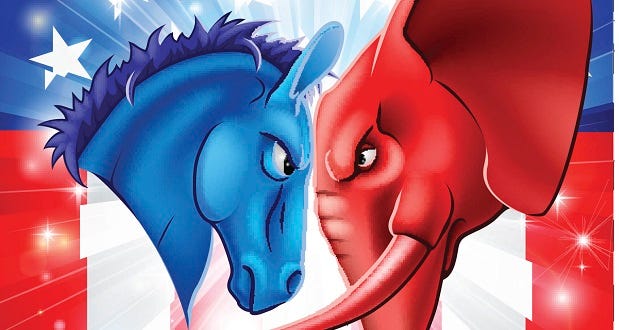As the United States approaches the 2022 Midterm Congressional elections, it is useful to step back and take a look at what our political parties mean today. Both of these parties extend far back into our history: the Democrats claim their origins lie with Thomas Jefferson’s Republican Party (sometimes called the Democratic/Republican Party for the sake of clarity, although I don’t that clarifies very much), while the Republicans trace their party back to 1854 when the party emerged as a coalition of anti-slavery groups in the country prior to the Civil War.
The coalitions of voters that support each of these parties have changed over the years. On some issues, the party positions have completely reversed. From 1860 through 1896, the Republicans supported a national economic strategy and protective tariffs. Their strength was in the northeastern part of the country, and they appealed primarily to industrialists and businessmen. If Africans-Americans voted (which they were not permitted to do throughout large parts of the country), they voted for Republicans. At this time, Democrats were the party of states’ rights and low tariffs. Their strength was concentrated in the Solid South, and they appealed to small farmers, unskilled labor, and immigrants.
Between 1896 and 1932, the Republicans were the party of big business and imperialism. They continued to appeal to businessmen and corporations. The Democrats had developed a progressive wing during this time period in addition to their hold on the South. They appealed to western farmers, immigrants, and urban voters.
Between 1932 and 1980, the Republicans were the party of laissez-fair economics, strict constructionism, and an emerging military hawkishness after World War II. Their strength was in the northeast and the Midwest, and they continued to appeal to elites and business interests. The Republican’s Southern Strategy was successful in moving southern whites into the Republican column by the end of this period. The Democrats were the party of Keynesian economics (meaning more government intervention in the economy), loose constructionism, and diplomacy rather than war. By the end of this period in 1980, they had lost their hold over white southern voters, but they appealed to a broad range of people in the “New Deal Coalition,” along with an emerging academic elite appeal. As the policy positions of the Republican party evolved to be more appealing to white Southerners, Blacks began to vote for Democrats. Since it was the Democrats (the urban progressive wing, not the Southern conservative wing) that promulgated the various pieces of Civil Rights legislation in the 1960s and 1970s, African-American voters have become the most loyal voting bloc for the Democrats.
After 1980, the Republicans solidified itself as the party of states’ rights. Their economic conservativism developed a theoretical base in supply-side economics. They became proponents of the idea of American Exceptionalism. Through the Southern Strategy (begun under Richard Nixon), they turned the South into a solidly Republican bastion while maintaining their hold on affluent voters, corporations, and social conservatives. The Democrats continued to press for Keynesian (demand-side) economic policy, a stronger central government, a multinational approach to the world, and social libertarianism. Their appeal has solidified in the northeast, on the Pacific coast, and in urban areas.
US voters are basically split into even thirds between Democrats, Republicans, and Independents. It is important to recognize that in 19 states (like Virginia) voters don’t register by political party so they don’t show up in these statistics. This includes most states across the South, so it is likely that the percentage of voters who consider themselves Republican is higher than this figure.
Take a look at the following tables and see what you think. (I took the following charts from the Pew Research Center website. The Pew Research Center, in existence since 2004, conducts opinion polling, demographic research, content analysis, and other data-driven social science research. Its research is well-regarded, without perceptible biases. Here’s the link to its website if you want to check it out https://www.pewresearch.org/)
















These data seem to indicate that Americans are so wide apart in their political views that we live in different realities. I despair.
Great piece today! Go Pew!